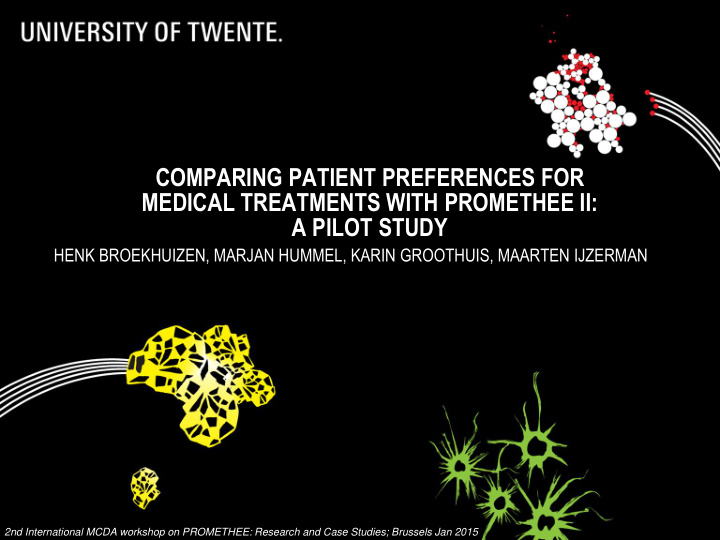



COMPARING PATIENT PREFERENCES FOR MEDICAL TREATMENTS WITH PROMETHEE II: A PILOT STUDY HENK BROEKHUIZEN, MARJAN HUMMEL, KARIN GROOTHUIS, MAARTEN IJZERMAN 2nd International MCDA workshop on PROMETHEE: Research and Case Studies; Brussels Jan 2015
OVERVIEW Our decision context and requirements Choice of MCDA method Pilot study with PROMETHEE II Methods Main results Sensitivity analysis (esp. relevant!) Discussion Future work
OUR DECISION CONTEXT AND REQUIREMENTS PROBLEM DEFINITION Decisions before drugs can be used: Market Access Reimbursement Prescribe MCDA a structured and transparent method to guide process Growing interest in health field (Diaby 2013, Marsh 2014, ISPOR taskforce) Patient perspective important, can be measured with stated preference methods This yields probabilistic preference data How can we transparently integrate these (probabilistic) preferences in a structured MCDA process?
OUR DECISION CONTEXT AND REQUIREMENTS WHAT MCDA METHOD TO USE IN CONJUNCTION WITH PROBABILISTIC DATA? Broekhuizen 2015 review approaches to deal with uncertainty in MCDA (569 studies identified)
REVIEW OF APPROACHES TO DEAL WITH UNCERTAINTY RESULTS: RESEARCH AREAS 250 200 3% in health-related 150 publication 100 50 0 H Broekhuizen 10/12/14 5
REVIEW OF APPROACHES TO DEAL WITH UNCERTAINTY RESULTS: UNCERTAINTY APPROACHES 300 257 250 200 150 86 100 50 32 26 18 0 Bayesian Deterministic Fuzzy set Grey theory Probabilistic framework framework theory framework H Broekhuizen 10/12/14 6
OUR DECISION CONTEXT AND REQUIREMENTS WHAT MCDA METHOD TO USE IN CONJUNCTION WITH PROBABILISTIC DATA? Top 3 MCDA methods used with probabilistic approach 40 35 30 25 20 15 10 5 0 AHP PROMETHEE SMAA
THE PILOT STUDY DESCRIPTION Goal : choose an antidepressant Alternatives : Venlafaxine, Bupropion, Duloxetine Criteria : 1) Response to treatment 2) Achieve remission 3) Minor side effects 4) Major side effects Weights AHP panel session with 12 patients But method would readily extend to larger sample sizes Performance scores derived from clinical trials that compared the drugs with placebo. Modeled in Visual PROMETHEE (academic edition) and R
THE PILOT STUDY SOURCE DATA Benefits Risks Response Remission Adverse events Severe adverse events Median weight 0.62 (0.36 to 0.78) 0.16 (0.07 to 0.34) 0.04 (0.01 to 0.23) 0.19 (0.02 to 0.25) (range) Odds ratio (95% CI) Dul vs Plc 1.95 (1.61 to 2.36) 1.91 (1.56 to 2.34) 1.91 (1.50 to 2.43) 0.96 (0.39 to 2.35) 1.80 (1.28 to 2.53) ‡‡ Ven vs Plc 2.04 (1.74 to 2.39) 1.97 (1.64 to 2.36) 1.27 (0.81 to 2.00) 1.55 (1.10 to 2.18) ‡‡ Bup vs Plc 1.48 (1.20 to 1.82) 1.46 (1.17 to 1.81) 0.39 (0.16 to 0.95)
PREFERENCE FUNCTION USED
MAIN RESULTS GLOBAL FLOWS AT AGGREGATE (GROUP) LEVEL AND FOR 9 PATIENTS
SENSITIVITY TO VARIATION IN WEIGHTS RANK STABILITY INTERVALS Response: [22%;100%], median = 62%, range 36% to 78% Remission: [0%;100%], median = 16%, range 7% to 34% Side effects: [0%;23%], median = 4%, range 1% to 23% Severe side effects: [0%;46%], median = 19%, range 2% to 25%
SENSITIVITY TO VARIATION WEIGHTS PROBABILISTIC ANALYSIS Bootstrapping weights, repeat 1000 times D V B
SENSITIVITY TO VARIATION WEIGHTS AND SCORES PROBABILISTIC ANALYSIS Sample odds ratios from lognormal distribution 1000 times B V D
COMPARISON WITH AHP RESULTS
DISCUSSION It is possible to compare the preferences of a large group of patients with PROMETHEE Group preferences and individual preferences can be contrasted Results similar to AHP results Problem: Visual PROMETHEE limited to 9 scenarios The meaning of weights? Can AHP weights really be used for PROMETHEE?
FUTURE WORK Supporting decision in early stages of health technology Case: novel imaging modalities for non-small cell lung cancer Klaske Siegersma (MSc student) will elicit from group of clinical experts: Relevant criteria Criteria weights Performance scores / preference functions Piloting weights elicitation for PROMETHEE among patients Problem: low numerical & health literacy Incomparability? Veto?
THANK YOU! More information: H.broekhuizen@utwente.nl http://www.utwente.nl/bms/htsr/Staff/broekhuizen/ Some references: V. Diaby, K. Campbell, and R. Goeree , “Multi -criteria decision analysis (MCDA) in health care: A bibliometric analysis,” Oper. Res. Heal. Care , vol. 2, no. 1 – 2, pp. 20 – 24, 2013. K. Marsh, T. Lanitis, D. Neasham , P. Orfanos, and J. Caro, “Assessing the Value of Healthcare Interventions Using Multi- Criteria Decision Analysis: A Review of the Literature,” Pharmacoeconomics , vol. 32, no. 4, pp. 1 – 21, 2014. H. Broekhuizen, C. Groothuis- Oudshoorn, J. van Til, M. Hummel, and M. IJzerman, “A review and classification of approaches for dealing with uncertainty in multi- criteria decision analysis for healthcare decisions,” Pharmacoeconomics , p. forthcoming, 2015. H. Broekhuizen, C. Groothuis-Oudshoorn, A. Hauber , and M. IJzerman, “Integrating patient preferences and clinical trial data in a quantitative model for benefit- risk assessment.,” in 25th Annual EuroMeeting of the Drug Information Association , 2012.
Recommend
More recommend